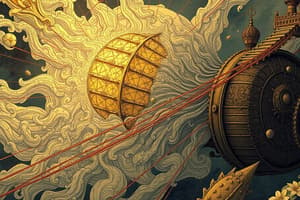Podcast
Questions and Answers
What is the equation used to calculate distance when initial velocity equals zero and acceleration is due to gravity?
What is the equation used to calculate distance when initial velocity equals zero and acceleration is due to gravity?
s = \frac{g}{2}t^{2}
What is the significance of the slope in the equation of the line y = mx + c when c = 0?
What is the significance of the slope in the equation of the line y = mx + c when c = 0?
- It represents the initial velocity
- It has no significance
- It represents the acceleration due to gravity (correct)
- It is equal to the time measured
Parallax error can be avoided when measuring distance in the experiment.
Parallax error can be avoided when measuring distance in the experiment.
False (B)
Which of the following is NOT a precaution to take during the experiment?
Which of the following is NOT a precaution to take during the experiment?
Why should different masses of spheres be used in the experiment?
Why should different masses of spheres be used in the experiment?
What is mass?
What is mass?
Mass is a vector quantity.
Mass is a vector quantity.
What is momentum?
What is momentum?
What is the SI unit of force?
What is the SI unit of force?
Which of the following is not one of Newton's laws of motion?
Which of the following is not one of Newton's laws of motion?
What is the formula for calculating weight?
What is the formula for calculating weight?
What happens when air resistance equals gravitational force?
What happens when air resistance equals gravitational force?
What is the reaction force acting on an object at rest on a surface?
What is the reaction force acting on an object at rest on a surface?
Friction opposes the motion of a ___
Friction opposes the motion of a ___
What is the relationship between the weight of an object and the planet's mass?
What is the relationship between the weight of an object and the planet's mass?
What does Newton's second law state?
What does Newton's second law state?
What is mass a measure of?
What is mass a measure of?
What is the SI unit of momentum?
What is the SI unit of momentum?
According to the conservation of momentum, what is true before and after an interaction?
According to the conservation of momentum, what is true before and after an interaction?
What is the velocity of the green puck after the collision?
What is the velocity of the green puck after the collision?
What is the change in momentum of the red puck?
What is the change in momentum of the red puck?
What is the formula that describes weight?
What is the formula that describes weight?
Newton's first law states that a body remains at rest unless acted upon by an external force.
Newton's first law states that a body remains at rest unless acted upon by an external force.
The force of attraction between two point masses is inversely proportional to the product of their masses.
The force of attraction between two point masses is inversely proportional to the product of their masses.
What unit is defined so that 1 N is the force that causes a body of mass 1 kg to accelerate by 1 m s-2?
What unit is defined so that 1 N is the force that causes a body of mass 1 kg to accelerate by 1 m s-2?
What happens when upward air resistance equals downward gravitational force?
What happens when upward air resistance equals downward gravitational force?
What does the normal reaction force act on?
What does the normal reaction force act on?
The formula for force is F = _____
The formula for force is F = _____
What is the acceleration of a sled of mass 60 kg pulled by a force of 500 N with a resistance of 80 N?
What is the acceleration of a sled of mass 60 kg pulled by a force of 500 N with a resistance of 80 N?
What is the slope of the graph plotting distance against time squared used to calculate?
What is the slope of the graph plotting distance against time squared used to calculate?
Flashcards are hidden until you start studying
Study Notes
Mass and Momentum
- Mass (m) measures the amount of matter in an object and is a scalar quantity with the SI unit of kilogram (kg).
- Momentum (p) is the product of mass and velocity, expressed as p = mass × velocity. It is a vector quantity with the SI unit kilogram metre per second (kg m s⁻¹).
- In a closed system, total momentum before an interaction equals total momentum after.
Sample Problem: Hockey Pucks Collision
- Two identical pucks collide: the red puck moves at 5 m s⁻¹ to the right; the green puck moves at 2 m s⁻¹ to the left.
- After collision, the red puck comes to rest.
- Use conservation of momentum to determine the green puck's velocity and each puck's change in momentum.
Force and Newton's Laws
- Force (F) is defined as that which can cause acceleration, a vector quantity measured in newtons (N).
- 1 N equals the force needed to accelerate a 1 kg mass by 1 m s².
- Newton's Laws:
- Law 1: An object at rest stays at rest, and an object in motion continues at constant velocity unless acted on by an external force.
- Law 2: The change in momentum is proportional to the applied force and in the direction of that force.
- Law 3: For every action, there is an equal and opposite reaction.
Weight and Forces in Fluids
- Weight (W) equals mass times the gravitational acceleration, making it a vector quantity measured in newtons.
- In fluids, objects face air resistance, a frictional force that increases with velocity. Terminal velocity occurs when this force equals gravitational force, resulting in constant speed.
Centre of Gravity and Gravity Variations
- Centre of gravity is where an object's weight appears to act.
- Acceleration due to gravity (g) varies with location due to Earth's shape (not perfectly spherical) and topographical differences like mountains and valleys.
Friction
- Friction (Fₓ) is a force opposing motion, influenced by surfaces' nature and the weight of the object.
- It allows vehicles and pedestrians to accelerate by providing grip.
Sample Problem: Sled on Snow
- A sled with a mass of 60 kg is pulled with a force of 500 N against a frictional resistance of 80 N.
- Resultant force can be calculated as tractive force minus friction.
- Acceleration can be calculated using the standard force equation.
Normal Reaction Forces
- Normal reaction force acts perpendicular to a surface, equal in magnitude and opposite in direction to an object's weight.
Experimental Procedures and Conclusions
- Experimental setups often involve measuring forces, masses, and accelerations to confirm principles like Newton’s laws and momentum conservation.
- Data is recorded and graphed to derive relationships, such as force versus acceleration, revealing that force is proportional to acceleration based on Newton's second law.
Precautions and Alternative Methods
- Ensure accurate measurements and minimize friction for more reliable results.
- Alternative methods using different equipment (e.g., air track, light gates) can yield similar findings and confirm physics principles consistently.
Conclusion
- Fundamental physics principles including mass, momentum, force, weight, air resistance, and gravity underlie various phenomena and can be tested through systematic experimentation and calculations.
Mass and Momentum
- Mass (m) measures the amount of matter in a body, represented as a scalar quantity in kilograms (kg).
- Momentum (p) is the product of mass and velocity (p = m × v), a vector quantity measured in kilograms metre per second (kg m/s).
- Conservation of momentum states that total momentum in a closed system before and after an interaction remains constant.
- Example shown with two colliding hockey pucks demonstrates conservation; the red puck stops, resulting in the green puck moving right at 3 m/s after collision.
Force and Newton's Laws
- Force (F) causes acceleration, defined as a vector quantity in newtons (N), where 1 N = 1 kg m/s².
- Newton's laws of motion:
- Law 1: An object remains at rest or in uniform motion unless acted upon by an external force. Example: Seat belts prevent passengers from continuing at constant velocity in a crash.
- Law 2: Rate of change of momentum is proportional to applied force, acting in the same direction. Example: Kicking a football applies force, resulting in acceleration.
- Law 3: For every action, there is an equal and opposite reaction. Example: Rockets propel forward by expelling gas backward.
Gravitational Force
- The gravitational force between two masses is proportional to their mass and inversely related to the distance squared (F ∝ 1/d²).
- Earth's gravity sustains its atmosphere; insufficient mass (like the Moon) leads to no atmosphere.
- Weight (W) is mass multiplied by gravitational acceleration (W = m × g); it is also a vector quantity measured in newtons.
Motion and Friction
- Air resistance, increasing with velocity, acts against a moving object. Terminal velocity occurs when upward air resistance equals downward gravitational force.
- Friction (Ff) opposes motion, its strength influenced by surface types and object weight; essential for grip in vehicles and shoes.
- Sample problem with sled: A 60 kg sled experiences a resultant force of 420 N and an acceleration of 7 m/s².
Normal Reaction Force
- An object on a surface exerts a normal reaction force (N) perpendicular to the surface, equal in magnitude and opposite in direction to the object's weight.
Experimental Procedures and Data Handling
- Several experiments outlined include:
- Measuring the relationship between force and acceleration using a ticker tape and trolley system, demonstrating that force is proportional to acceleration.
- Using free-fall apparatus to calculate acceleration due to gravity by squaring time and plotting distance versus time squared, where gravitational acceleration is twice the slope of the graph.
- Precautions for experiments include reducing friction, ensuring proper apparatus alignment, and accounting for external factors to enhance accuracy.
Conclusion
- The experiments reinforce the foundational principles of mechanics, including momentum conservation, force interactions, and gravitational effects, with careful data collection and error reduction techniques emphasized for reliability.
Studying That Suits You
Use AI to generate personalized quizzes and flashcards to suit your learning preferences.




